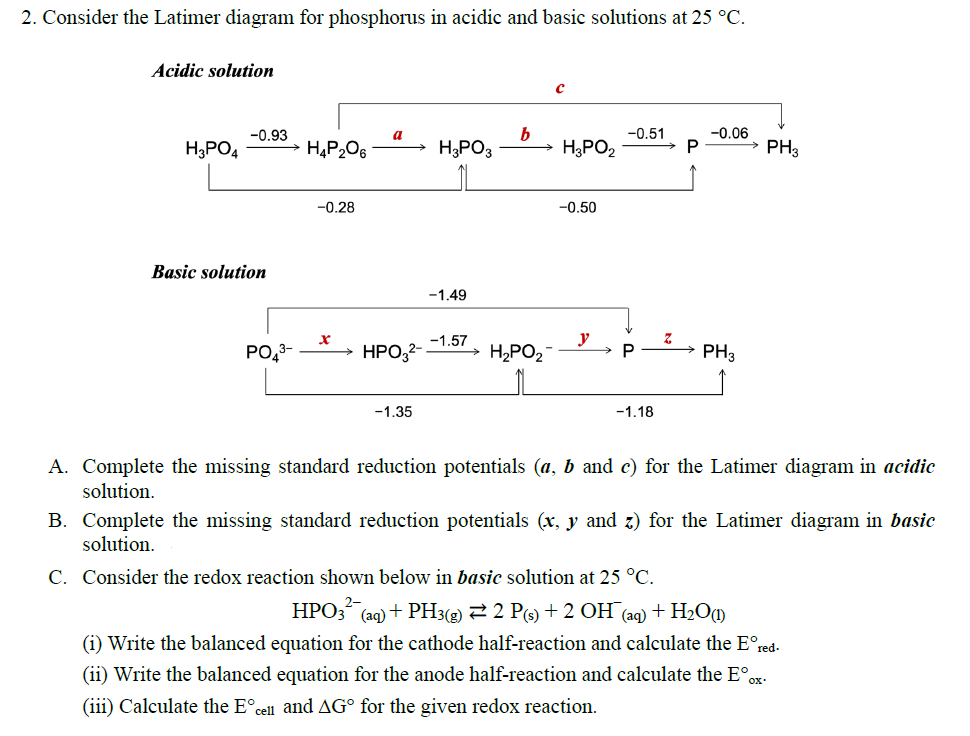Chemistry: Principles and Reactions
8th Edition
ISBN:9781305079373
Author:William L. Masterton, Cecile N. Hurley
Publisher:William L. Masterton, Cecile N. Hurley
Chapter17: Electrochemistry
Section: Chapter Questions
Problem 74QAP: Consider the reaction low at 25°C: 3SO42(aq)+12H+(aq)+2Cr(s)3SO2(g)+2Cr3+(aq)+6H2O Use Table 17.1 to...
Related questions
Question
please show step by step solution

Transcribed Image Text:2. Consider the Latimer diagram for phosphorus in acidic and basic solutions at 25 °C.
Acidic solution
H3PO4
-0.93
Basic solution
PO4³-
H4P₂O6
-0.28
a
HPO3²-
-1.35
H3PO3
-1.49
-1.57
b
H₂PO₂
H₂PO₂2
-0.50
y
-0.51
P
-1.18
-0.06
PH3
PH3
A. Complete the missing standard reduction potentials (a, b and c) for the Latimer diagram in acidic
solution.
B. Complete the missing standard reduction potentials (x, y and z) for the Latimer diagram in basic
solution.
C. Consider the redox reaction shown below in basic solution at 25 °C.
HPO32- (aq) )+ PH3(g) ₹ 2 P(s) + 2 OH (aq) + H₂O(1)
(i) Write the balanced equation for the cathode half-reaction and calculate the Eºred-
(ii) Write the balanced equation for the anode half-reaction and calculate the Eºox.
(iii) Calculate the Eᵒcell and AG for the given redox reaction.
Expert Solution
This question has been solved!
Explore an expertly crafted, step-by-step solution for a thorough understanding of key concepts.
This is a popular solution!
Trending now
This is a popular solution!
Step by step
Solved in 5 steps with 4 images

Follow-up Questions
Read through expert solutions to related follow-up questions below.
Follow-up Question
B and C..... please show step by step solution
Solution
Knowledge Booster
Learn more about
Need a deep-dive on the concept behind this application? Look no further. Learn more about this topic, chemistry and related others by exploring similar questions and additional content below.Recommended textbooks for you

Chemistry: Principles and Reactions
Chemistry
ISBN:
9781305079373
Author:
William L. Masterton, Cecile N. Hurley
Publisher:
Cengage Learning

Chemistry
Chemistry
ISBN:
9781305957404
Author:
Steven S. Zumdahl, Susan A. Zumdahl, Donald J. DeCoste
Publisher:
Cengage Learning

Chemistry: An Atoms First Approach
Chemistry
ISBN:
9781305079243
Author:
Steven S. Zumdahl, Susan A. Zumdahl
Publisher:
Cengage Learning

Chemistry: Principles and Reactions
Chemistry
ISBN:
9781305079373
Author:
William L. Masterton, Cecile N. Hurley
Publisher:
Cengage Learning

Chemistry
Chemistry
ISBN:
9781305957404
Author:
Steven S. Zumdahl, Susan A. Zumdahl, Donald J. DeCoste
Publisher:
Cengage Learning

Chemistry: An Atoms First Approach
Chemistry
ISBN:
9781305079243
Author:
Steven S. Zumdahl, Susan A. Zumdahl
Publisher:
Cengage Learning


World of Chemistry, 3rd edition
Chemistry
ISBN:
9781133109655
Author:
Steven S. Zumdahl, Susan L. Zumdahl, Donald J. DeCoste
Publisher:
Brooks / Cole / Cengage Learning